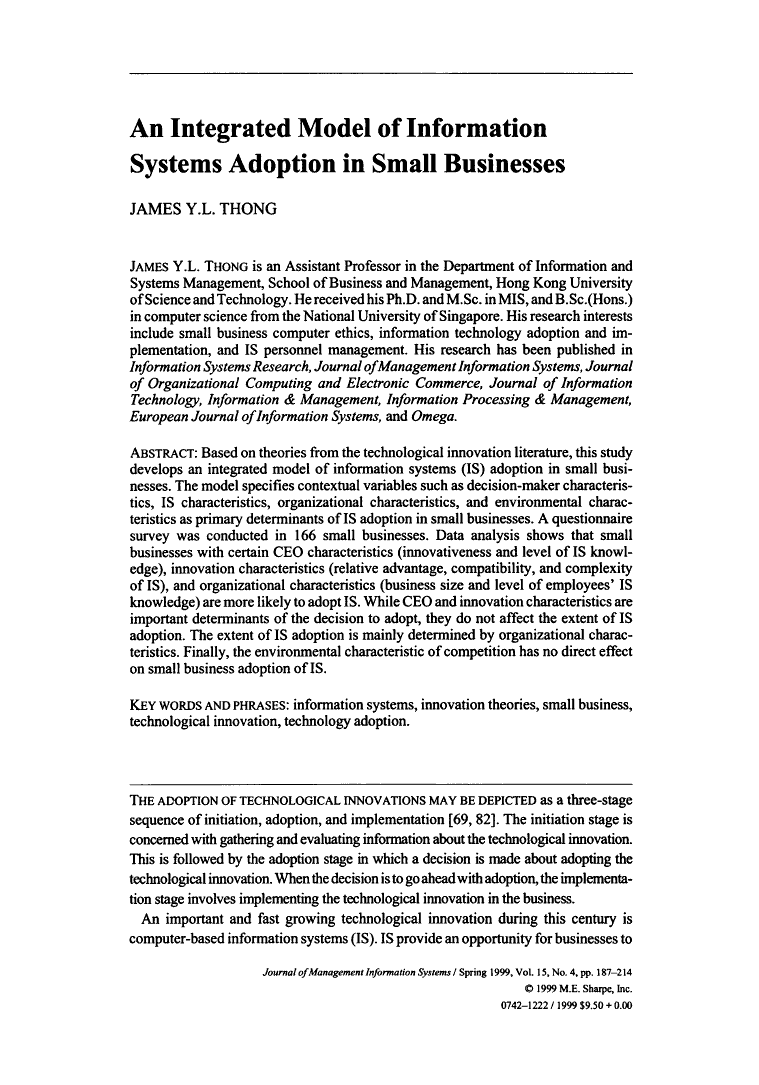"What the paper says" Critique

Paper Title: An Integrated Model of Information Systems Adoption in Small Businesses
Author: James Y. L. Thong
Summary of the Content of Paper:
| This article offers a comprehensive exploration of the factors influencing the adoption of information systems (IS) within small businesses. Grounded in technology innovation literature, the study presents a model delineating four primary determinants - CEO characteristics, IS characteristics, organizational characteristics, and environmental characteristics - impacting IS adoption. The author conducted a survey of 166 small businesses in Singapore to test the model. The results show that CEO innovativeness, CEO IS knowledge, IS attributes like relative advantage and compatibility, business size, and employee IS knowledge positively influence the likelihood of IS adoption. For existing adopters, business size, employee IS knowledge, and information intensity determine the extent of IS adoption. Competition has no direct effect on adoption decisions. |
A: Quality of the Research
| Item | Comments |
| 1. Is the research question or objective clearly stated? | Yes. "There are two related but distinct research questions: (1) What variables determine the decision of small businesses to adopt IS? and (2) If the decision is to adopt IS, what variables determine the extent of IS adoption?" |
| 2. Is the research question interesting and important? | Definitely. Given the immense benefits of IS for small businesses, and the evidence of slow adoption, it is important to examine the contributing factors to this slow adoption in order to inform theory and practice. |
| 3. Is the work original? | Yes, the work appears highly original. The author states that to their knowledge, this is one of the first rigorous empirical studies testing an integrated theoretical model to explain IS adoption in small businesses, using a relatively large sample size and robust statistical analysis techniques. Additionally, the study examines these relationships in the under-researched context of small firms in Singapore rather than US-centric samples in most similar research. |
| 4. Is the background research clear and relevant? | Yes. Leveraging the technological innovation literature as the theoretical foundation provides a robust framework that enhances the understanding of the complex dynamics involved in adopting new technologies. It offers both theoretical depth and practical insights, fostering a comprehensive analysis of factors influencing the adoption process within this specific context. |
| 5. Are there any ethical problems? | The article does not seem to have any major ethical problems. Some indicators that support this include:
|
B: The Research Method
| Item | Comments |
| Summarize the research method | The research method is sound, using a questionnaire-based survey of 166 small businesses meeting reasonable criteria. Multiple items are used to measure each research construct, with factor analysis demonstrating adequate reliability and validity. |
| Does the research method seem appropriate for the research question? | Yes. Using a structured questionnaire survey is a common and effective method for gathering data on the perceptions and behaviors of business owners, especially in studies focusing on technology adoption. |
| Are the methods adequately described? | The method is adequately described detailing information on the design of the questionnaire, the sample size, and the statistical techniques used for data analysis. This includes discriminant analysis and Pearson correlation, which are appropriate for the study's objectives. The article also details how the variables were measured, ensuring transparency in the research process. |
| Were the analyses done correctly? | The results and hypothesis tests are clearly reported in tables. Insights and conclusions are drawn objectively based on the empirical analyses outcomes regarding significant predictors of IS adoption likelihood and extent in small firms. Only statistically significant relationships are used to derive implications. |
| Are the conclusions supported by the data? | Since the analyses methods are relevant, rigorously done and support the inferences made, the conclusions seem adequately backed by the collected and analysed data in this study. |
C: Quality of Presentation
| Item | Comments |
| Is the work well presented? Is the paper well structured? Are symbols, terms, and concepts adequately defined? | The article is well-structured, with clear sections including theoretical background, research model, methodology, and analysis. The arguments are logically presented, with effective use of tables and figures to illustrate points. However, the extensive use of technical terms and statistical jargon might limit its accessibility to readers not familiar with advanced research methodologies. |
D: Additional Notes
| Use this section to record additional notes on the paper. In particular you should identify any links to other topics and papers from the module | In conclusion, the study is both timely and relevant for the IS field. The findings offer actionable insights for small businesses, policy makers and technology vendors.However, the research context limited to Singaporean small businesses may restrict the generalizability of findings to broader global contexts. Additionally, the survey-based approach might introduce response biases or overlook unexplored variables that could affect IS adoption. |
Comments